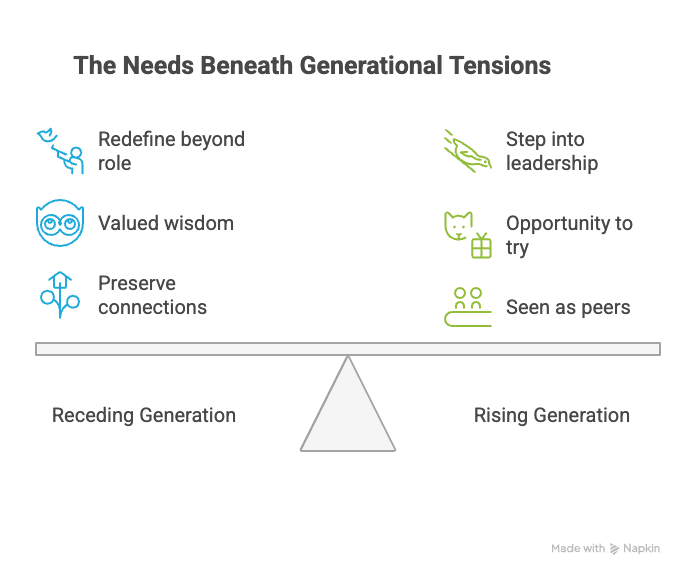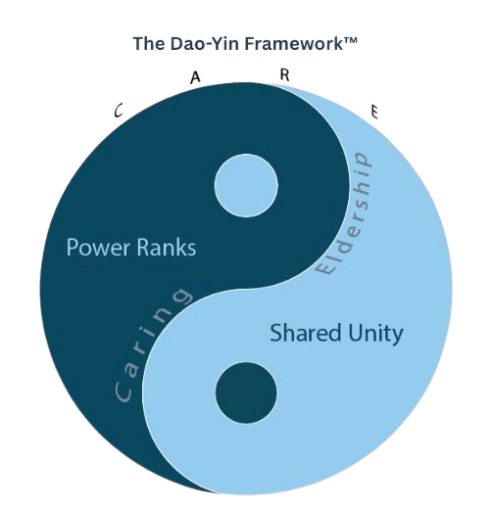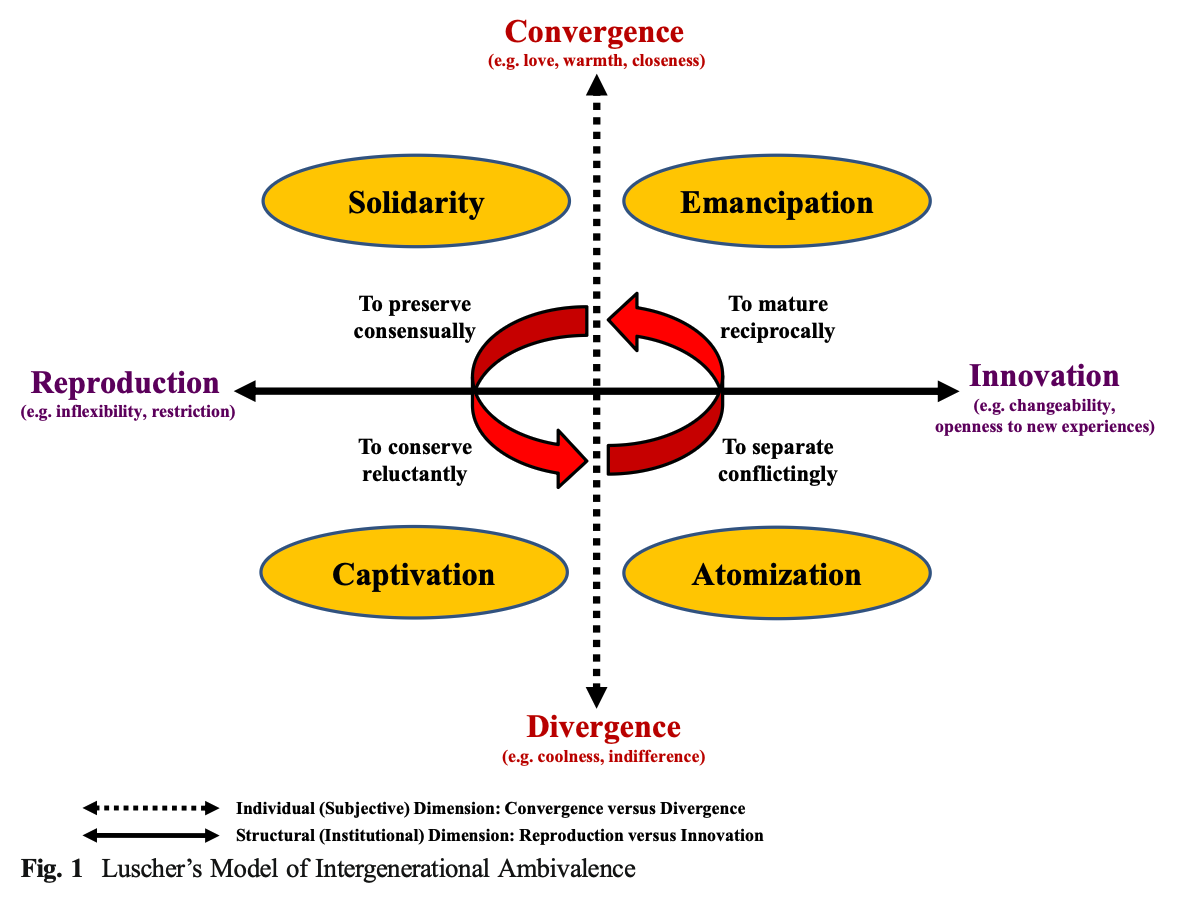Care at the Threshold: Leading Through Generational Passage
By Baozhen M. Luo-Hermanson, PhD
July 8, 2025
In June 2025, a striking generational moment unfolded in American politics. Thirty-three-year-old Zohran Mamdani, a Millennial assembly member and democratic socialist from Queens, won the Democratic primary for the New York City mayoral race, defeating 67-year-old former governor Andrew Cuomo, a prominent Baby Boomer from the establishment wing of the party.
Mamdani's campaign, propelled by grassroots energy and digital fluency, reflected not only a political upset but a deeper generational overturn.
The energy of this race—the intensity of its challenge, the shock of its outcome, and the symbolic victory of the younger over the older—reminds me of a Chinese saying:
"长江后浪推前浪,前浪死在滩头上。"
"The waves of the Yangtze River surge one after another; the front wave dies on the shore."
It is often shared with a smirk, as a generational jab, but beneath its sharp humor lies a profound truth: the generational tide is shifting, and with it, a reckoning with power, identity, and place.
Mamdani's victory is not an isolated event. It is a harbinger.
Millennials—those born between 1981 and 1996—are now the largest adult generation in the U.S., having overtaken the Baby Boomers. Almost all Millennials are in their 30s and 40s, entering the prime of their professional lives.
This generational ascension is not limited to the U.S.; across much of the world, Millennials are rising into leadership as older generations recede. From Canada to Korea, Brazil to Germany, a quiet but powerful tide is shifting—demographically, culturally, and structurally.
Baby Boomers, now at least 61 years old, are retiring en masse, and the size of their cohort is shrinking due to mortality. Caught between these currents is Generation X, smaller in number and often overlooked, even as it bears the weight of middle leadership. Meanwhile, Gen Z is rushing into the workforce, redefining norms as they arrive.
Demographically and culturally, Millennials are poised to inherit the helm.
The next two decades will witness a massive transfer of generational power—not just in politics, but across industries, organizations, and cultural life. The energy is palpable, a gathering force beneath the surface.
A big wave is coming.
The Liminal Space of Ambivalence
Not all generational succession makes headlines like the dramatic turnover we see in politics or sports. Beneath the surface of many organizations—especially in this decade of generational shift—a profound change is quietly unfolding, often accompanied by significant challenge and pain.
This is not limited to family-owned businesses, though the stakes can be particularly high there due to strong emotional ties and the entanglement of kinship and capital. In nonprofits, academic institutions, tech start-ups, foundations, and government agencies alike, leaders are contending with complex questions: Who is ready to lead? Who is willing to let go? What still needs to be said, reconciled, handed down?
These transitions may happen in quiet rooms—search committees, board meetings, off-the-record chats—where power shifts silently, almost imperceptibly. But what's invisible is not unfelt. Beneath the smooth veneer of "business as usual," a deeper emotional and structural tide is moving.
That tide is marked by ambivalence.
Ambivalence is often mistaken for ambiguity, but they are not the same. Ambiguity implies uncertainty or lack of clarity. Ambivalence names something more charged: when two opposing forces are equally real. Love and resentment. Admiration and rivalry. Respect and dismissal. Tradition and innovation.
I've felt this from both ends of the generational arc.
As a young scholar, when my research began attracting media attention, a senior Gen X colleague who had once supported me responded with a biting question: "How did they find you?" It wasn't curiosity—it was disbelief. A subtle challenge to my legitimacy.
Years later, a former student—now a public leader in her thirties—visited me and, before leaving, offered: "If there's ever anything you'd like to learn from me, please don't hesitate." Then she paused, embarrassed. "I know that might sound weird." But it didn't. It sounded right. And it revealed something in me too: pride, yes—but also the quiet ache of being surpassed.
These are the emotional contours of intergenerational ambivalence.
First explored by Bleuler and Freud in psychology, ambivalence found a second home in sociology. Karl Lüscher gave the concept a generational lens, defining intergenerational ambivalence as:
"Dilemmas and polarizations of feelings, thoughts, actions, and contradictions in social relations and social structures, which are relevant for personal and societal development, and are interpreted as being basically irreconcilable."
Though rooted in studies on family relationships, this concept powerfully explains what unfolds in workplaces and institutions undergoing leadership transition. When this tide of intergenerational ambivalence moves outside the awareness of leadership, it doesn't disappear—it simply works behind the scenes, shaping behaviors, decisions, and relationships in ways that may go unnoticed until real harm is done.
For example:
Delayed Succession: A beloved nonprofit founder in her late 70s delays retirement despite naming a successor. The Millennial deputy, tired of waiting, leaves. The organization loses both continuity and the fresh leadership it had prepared for.
Weakened Trust: A Gen X CEO in a family business regularly second-guesses his Millennial deputy in public, calling it mentorship. The younger leader feels mistrusted; the team loses confidence as leadership appears fractured.
Shallow Leadership Bench: In a tech start-up, senior leaders hoard authority while offering younger staff inflated titles but little real responsibility. When crisis hits, there's no one ready to step up—not from lack of talent, but lack of development.
Unresolved Conflict: At a university, tensions rise between older faculty and younger faculty pushing for critical race and decolonial approaches. Power struggles over course decisions mask deeper, unspoken ambivalence on both sides.
Erosion of Organizational Memory: A Millennial leader at a philanthropic foundation enacts sweeping reforms but sidelines veteran staff. Elders quietly disengage, taking with them vital history and relationships. Innovation accelerates—but the organization loses its roots.
In each of these cases, the consequences are not simply the result of poor planning or personality clashes—they're the result of ambivalence left unacknowledged.
During generational succession, organizations often falter not for lack of vision—but for lack of understanding. When the emotional and structural tides of generational change are not named and met with intention, they do not go away. They simply find other ways to assert themselves, often when it's too late to respond with care.
That is why naming ambivalence is not a luxury of reflective leadership—it is a prerequisite for generational stewardship.
Holding Ambivalence with Care
After being named, intergenerational ambivalence must be held with care—Care Intelligence, to be precise. And it must be held by both the receding and the rising generations.
Care Intelligence invites you to first recognize that beneath generational tension are very human needs. According to self-determination theory, three core psychological needs shape our motivations and well-being: autonomy, competence, and relatedness. These needs are present in both outgoing and incoming leaders—but they are often expressed differently.
For the receding generation, autonomy may mean the ability to redefine themselves beyond their institutional role. Competence may mean feeling that their accumulated wisdom is still valued. Relatedness may mean preserving meaningful connections with their colleagues and their legacy.
For the rising generation, autonomy may mean stepping into leadership with clarity and confidence. Competence may mean the opportunity to try new things, make mistakes, and still be trusted. Relatedness may mean being seen as peers, not protégés—collaborators, not children.
When these needs go unmet, ambivalence calcifies into power struggles or emotional withdrawal. But when leaders practice Care Intelligence, they begin to perceive these needs with empathy rather than ego, as relational invitations rather than personal threats.
Then, Care Intelligence asks leaders to access both Power Awareness and Unity Awareness to help have these needs met, for themselves as well as for their younger/older counterparts.
Power Awareness is the capacity to recognize, negotiate, and share power consciously and responsibly. It supports receding leaders in letting go of control with dignity—and helps rising leaders step into power with discernment.
A retiring executive resists the urge to "correct" decisions made by their successor, even when those decisions differ from their own. Instead, they offer affirmation from the sidelines, trusting the next generation to steer the course. A newly promoted Millennial director takes the time to acknowledge the long arc of their organization's growth, naming the shoulders they stand on before charting a new direction.
Power Awareness asks: Where do I need to step back with grace? Where do I need to step forward with care?
Unity Awareness is the capacity to foster connection, psychological safety, and shared purpose across differences and power hierarchy. It invites both generations to cultivate belonging even as roles change.
A Baby Boomer leader prepares for succession not by disappearing, but by initiating reflective dialogues: What wisdom still needs to be passed down? What am I being invited to let go of? A Millennial leader launching a bold new initiative invites their predecessor to review and bless it—not for approval, but for acknowledgment of lineage and legacy.
Unity Awareness asks: How do we stay connected across the threshold? What needs to be honored—not just changed?
When Power Awareness and Unity Awareness are both practiced with maturity, they give rise to something deeper: eldership. Eldership is the capacity to lead with wisdom—exercising power without domination and fostering unity without dissolving direction.
It allows leaders, whether rising or receding, to steward transition not as a loss or conquest, but as a sacred responsibility. In times of generational succession, eldership becomes the anchor that carries organizations forward with grace.
Succession as Passage—And a Call to Care
To view intergenerational succession merely as a shift in titles or authority is to miss its deeper significance. Succession, at its most meaningful, is not a transaction—it is a passage. A shared threshold that invites both the receding and rising generations to cross, not in isolation, but in relation.
When we treat succession as passage, we begin to ask different questions:
What is being carried across—not just in responsibility, but in wisdom and spirit?
What must be released for new leadership to take root?
What is unfinished or unsaid that still lingers beneath the surface?
Here, the four-quadrant model of intergenerational ambivalence developed by sociologist Karl Lüscher offers a helpful lens. Originally developed to understand relationships between adult children and aging parents, Lüscher's model helps us see how institutions and communities also express these patterns—especially during leadership transition.
The four patterns arise from two tensions: a structural tension between innovation and reproduction, and a subjective tension between closeness and distance. These tensions shape whether we move through succession with creativity and care—or with conflict, withdrawal, or rupture.
Emancipation: Innovation with Connection is the space where change and closeness coexist. Receding leaders share their wisdom without clinging. Rising leaders step forward without severing ties. A sense of mutuality opens—change is welcomed, and belonging is preserved.
When New York City Comptroller Brad Lander, a Gen X leader, and Millennial candidate Zohran Mamdani endorsed each other, they did more than cast votes—they made space for ambivalence to turn into alignment.
In organizations, this shows up in thoughtful mentoring, co-leadership transitions, and storytelling rituals that carry memory into the future.
Solidarity: Stability without Change preserves respect but narrows possibility. Solidarity is present—but it may come at the cost of growth.
Sometimes this is born of reverence; sometimes of fear. A retiring founder stays on indefinitely "to help," but makes every decision feel provisional. A rising director hesitates to bring fresh ideas, worried about seeming disloyal. Succession happens on paper—but not in spirit.
This can be a stabilizing place in uncertain times—but one that risks institutional stagnation if it becomes permanent.
Captivation: Control without Connection is the pattern of power held tightly, without trust or openness. Receding leaders resist letting go; rising leaders feel shut out or patronized. What could have been a generative transition becomes an extended struggle.
This happens in family firms where founders refuse to retire, or in nonprofits where previous directors still "hover." Guidance becomes gatekeeping. Legacy is used as leverage.
There is no soft landing here—only endurance.
Atomization: Change without Memory sees the younger generation moving quickly—but without connection to what came before. Innovation dominates. Relationship, context, and lineage are dismissed as irrelevant.
This can happen when a new leader enters with an overhaul mindset, discarding old programs without understanding their roots. Or when a rising team is so eager to differentiate themselves that they erase the past rather than evolve it.
Momentum is strong here—but it can be isolating. And ultimately unsustainable.
Moving Through, Not Around
Lüscher noted that these patterns are not fixed. They are not destinies. They are responses—conditioned by how ambivalence is named, understood, and held.
What moves us from captivation or atomization toward emancipation is not just strategy—it is care.
Care Intelligence offers a pathway.
It helps receding leaders honor what they've built while letting go with grace. It helps rising leaders bring bold ideas while carrying memory with respect. It helps institutions grow without forgetting who they are.
And it helps us—all of us—remember that generational succession is not simply about who comes next. It's about how we move together through time. How we witness one another across change. How we acknowledge loss, welcome renewal, and tend the space in between.
Because in the end, we are not just waves overtaking one another. We are water, in the same body, shaped by the same riverbed.
And we rise best when we rise together.






